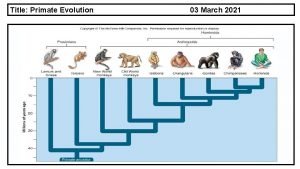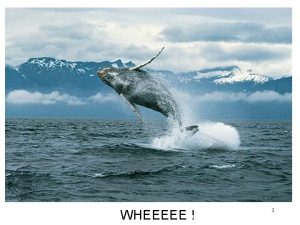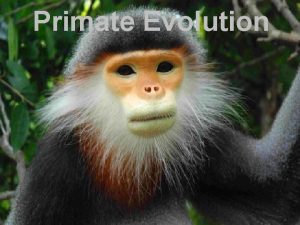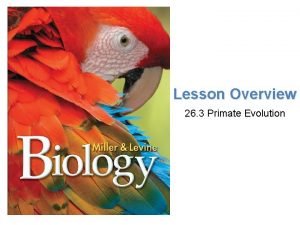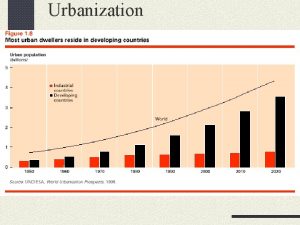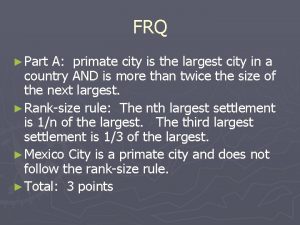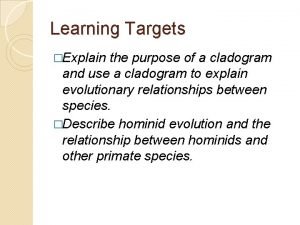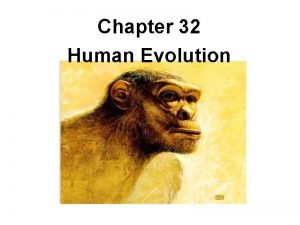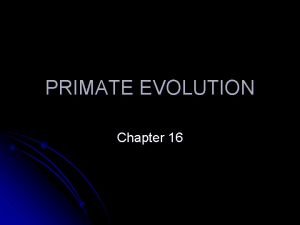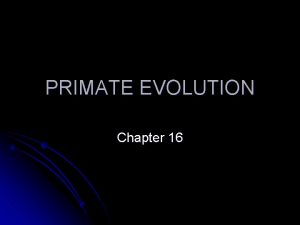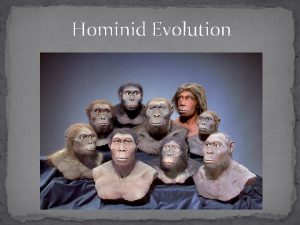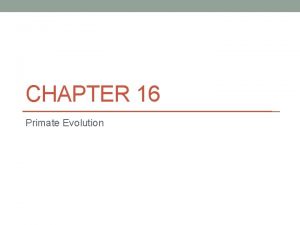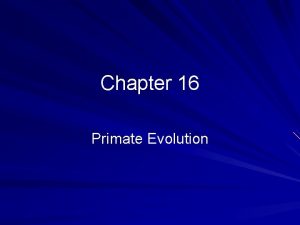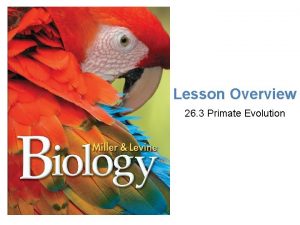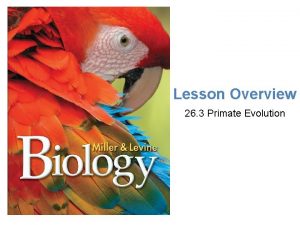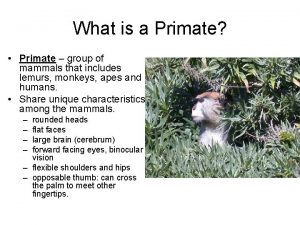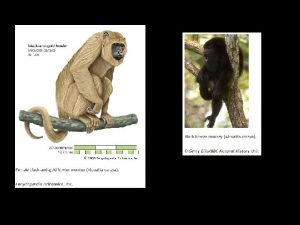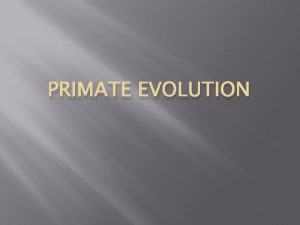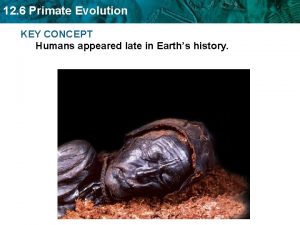Lesson Overview Primate Evolution Lesson Overview 26 3























- Slides: 23

Lesson Overview Primate Evolution Lesson Overview 26. 3 Primate Evolution

Lesson Overview Primate Evolution What Is a Primate? Primates share several adaptations for a life spent in trees. In general, a primate is a mammal that has relatively long fingers and toes with nails instead of claws, arms that can rotate around shoulder joints, a strong clavicle, binocular vision, and a welldeveloped cerebrum.

Lesson Overview Primate Evolution of Primates: Early in their history, primates split into two groups.

Lesson Overview Primate Evolution Lemurs and Lorises Lemurs and lorises are small, nocturnal primates with large eyes adapted to seeing in the dark. Many have long snouts.

Lesson Overview Primate Evolution Tarsiers and Anthropoids, or humanlike primates, include monkeys, great apes, and humans.

Lesson Overview Primate Evolution New World Monkeys The New World monkeys are found in Central and South America. Members of this group live almost entirely in trees. They have long, flexible arms that enable them to swing from branches. New World monkeys also have a long, prehensile tail that can coil tightly enough around a branch to serve as a “fifth hand. ”

Lesson Overview Primate Evolution Old World Monkeys and Great Apes The other anthropoid branch, which evolved in Africa and Asia, includes the Old World monkeys and great apes. Old World monkeys spend time in trees but lack prehensile tails.

Lesson Overview Primate Evolution Old World Monkeys and Great Apes Great apes, also called hominoids, include gibbons, orangutans, gorillas, chimpanzees, and humans. Recent DNA analyses confirm that, among the great apes, chimpanzees are humans’ closest relatives.

Lesson Overview Primate Evolution Hominine Evolution The hominoids in the lineage that led to humans are called hominines and include modern humans and all other species more closely related to us than to chimpanzees.

Lesson Overview Primate Evolution Hominine Evolution The evolution of bipedal, or twofooted, locomotion was very important, because it freed both hands to use tools. The hominine hand evolved an opposable thumb that could touch the tips of the fingers, enabling the grasping of objects and the use of tools. Hominines evolved much larger brains.

Lesson Overview Primate Evolution New Findings and New Questions The study of human ancestors is exciting and constantly changing. Recent discoveries in Africa have doubled the number of known hominine species and the length of the known hominine fossil record. These data have enhanced the picture of our species’ past, but questions still remain as to how fossil hominines are related to one another—and to humans.

Lesson Overview Primate Evolution The Oldest Hominine? In 2002, paleontologists in Africa discovered a fossil skull roughly 7 million years old. This fossil, called Sahelanthropus, is a million years older than any known hominine.

Lesson Overview Primate Evolution Australopithecus Hominines of the genus Australopithecus lived from about 4 million to about 1. 5 million years ago. Australopithecus afarensis fossils are shown. These hominines were bipedal apes, but their skeletons suggest that they probably spent some time in trees. The structure of their teeth suggests a diet rich in fruit.

Lesson Overview Primate Evolution Lucy The best-known A. afarensis specimen is a partial skeleton of an adult female discovered in 1974, nicknamed “Lucy. ” Lucy stood about 1 meter tall and lived about 3. 2 million years ago.

Lesson Overview Primate Evolution The Dikika Baby In 2006, an Ethiopian researcher announced the discovery of some 3. 3 million-year-old fossils of a very young A. afarensis female, nicknamed “the Dikika Baby. ” Leg bones confirmed that the Dikika Baby walked bipedally, while her arm and shoulder bones suggest that she would have been a better climber than modern humans.

Lesson Overview Primate Evolution The Genus Homo The fossils of this new group of hominine species resemble modern human bones, and so they are classified in the genus Homo. One set of fossils was found with tools made of stone and bone, so it was named Homo habilis, which means “handy man” in Latin.

Lesson Overview Primate Evolution Out of Africa—But When and Who? Researchers agree that our genus originated in Africa and migrated from there to populate the world. Some current hypotheses about when hominines first left Africa and which species made the trip are shown in the figure.

Lesson Overview Primate Evolution The First Homo sapiens There are two main hypotheses of how Homo sapiens arose. The multiregional model suggests that, in several parts of the world, modern humans evolved independently from widely separated populations of H. erectus. The “out-of-Africa” model proposes that modern humans evolved in Africa about 200, 000 years ago, migrated through the Middle East, and replaced the descendants of earlier hominine species.

Lesson Overview Primate Evolution The First Homo sapiens Recently, molecular biologists analyzed mitochondrial DNA from living humans around the world and determined they last shared a common African ancestor between 200, 000 and 150, 000 years ago. More recent DNA data suggest that a small subset of those African ancestors left northeastern Africa between 65, 000 and 50, 000 years ago to colonize the world, supporting the out-of-Africa hypothesis.

Lesson Overview Primate Evolution Modern Humans The story of modern humans over the past 200, 000 years involves two main species: Homo neanderthalensis and Homo sapiens.

Lesson Overview Primate Evolution Homo neanderthalensis Neanderthals flourished in Europe and western Asia beginning about 200, 000 years ago. Evidence suggests that they made stone tools, lived in complex social groups, had controlled use of fire, were excellent hunters, and performed simple burial rituals. Neanderthals survived in parts of Europe until about 28, 000– 24, 000 years ago.

Lesson Overview Primate Evolution Modern Homo sapiens Anatomically modern Homo sapiens arrived in the Middle East from Africa about 100, 000 years ago. By about 50, 000 years ago, H. sapiens populations, including some now known as Cro-Magnons, were using new technology to make more sophisticated stone blades and were making tools from bones and antlers. They produced spectacular cave paintings and buried their dead with elaborate rituals.

Lesson Overview Primate Evolution Modern Homo sapiens Both Neanderthals and H. sapiens moved into Europe, where they coexisted for several thousand years. For the last 24, 000 years, however, Homo sapiens have been Earth’s only hominine. Why did Neanderthals disappear? Did they interbreed with H. sapiens? No one knows for sure.
 Primate evolution tree
Primate evolution tree Chapter 16 primate evolution assessment answer key
Chapter 16 primate evolution assessment answer key Chapter 16 primate evolution
Chapter 16 primate evolution Land whales
Land whales Evolution of primates
Evolution of primates Primate evolution tree
Primate evolution tree Is mexico city a primate city
Is mexico city a primate city Rank size rule definition
Rank size rule definition Primate city
Primate city What is rank size rule
What is rank size rule Primate traits
Primate traits Primate city
Primate city Primate city frq
Primate city frq Primate suite of traits
Primate suite of traits The law of primate city
The law of primate city Primate taxonomy
Primate taxonomy Linguoversion definition
Linguoversion definition Cladogram purpose
Cladogram purpose Predentate period
Predentate period Primate space dental
Primate space dental Borchert's epochs ap human geography definition
Borchert's epochs ap human geography definition Primate husbandry
Primate husbandry Fossil diversity
Fossil diversity Homnidos
Homnidos
